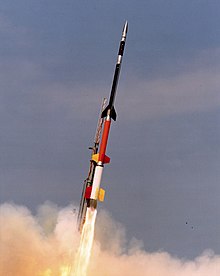
A sounding rocket or rocketsonde, sometimes called a research rocket or a suborbital rocket, is an instrument-carrying rocket designed to take measurements and perform scientific experiments during its sub-orbital flight. The rockets are used to launch instruments from 48 to 145 km (30 to 90 miles)[1] above the surface of the Earth, the altitude generally between weather balloons and satellites; the maximum altitude for balloons is about 40 km (25 miles) and the minimum for satellites is approximately 121 km (75 miles).[2] Certain sounding rockets have an apogee between 1,000 and 1,500 km (620 and 930 miles), such as the Black Brant X and XII, which is the maximum apogee of their class. For certain purposes Sounding Rockets may be flown to altitudes as high as 3,000 kilometers to allow observing times of around 40 minutes to provide geophysical observations of the magnetosphere, ionosphere, thermosphere and mesosphere.[3] Sounding rockets have been used for the examination of atmospheric nuclear tests by revealing the passage of the shock wave through the atmosphere.[4] [5] In more recent times Sounding Rockets have been used for other nuclear weapons research.[6] Sounding rockets often use military surplus rocket motors.[7] NASA routinely flies the Terrier Mk 70 boosted Improved Orion, lifting 270–450-kg (600–1,000-pound) payloads into the exoatmospheric region between 97 and 201 km (60 and 125 miles).[8]
- ^ nasa.gov NASA Sounding Rocket Program Handbook, June 2005, p. 1
- ^ "NASA Sounding Rocket Program Overview". NASA Sounding Rocket Program. NASA. 24 July 2006. Retrieved 10 October 2006.
- ^ "High Altitude Sounding Rocket" (PDF). NASA Sounding Rocket Program. NASA. 29 September 2024. Retrieved 29 September 2024.
- ^ "Rope Trick effect" (PDF). Wikipedia. 29 September 2024. Retrieved 29 September 2024.
- ^ "Rope Trick effect". Rapatronic Photography. Navada National Security Site. 29 September 2024. Retrieved 29 September 2024.
- ^ "Sandia delivers first DOE sounding rocket program since 1990s". Rapatronic Photography. Sandia National Labrtories. 29 September 2024. Retrieved 29 September 2024.
- ^ Cite error: The named reference
whatwas invoked but never defined (see the help page). - ^ NASA Sounding Rocket Handbook